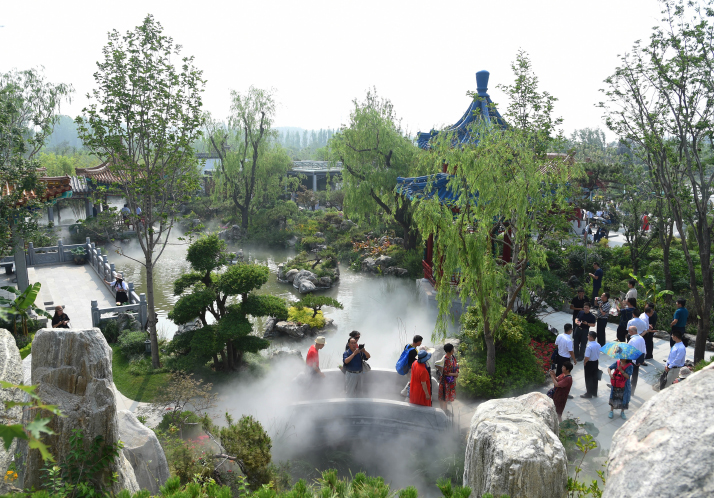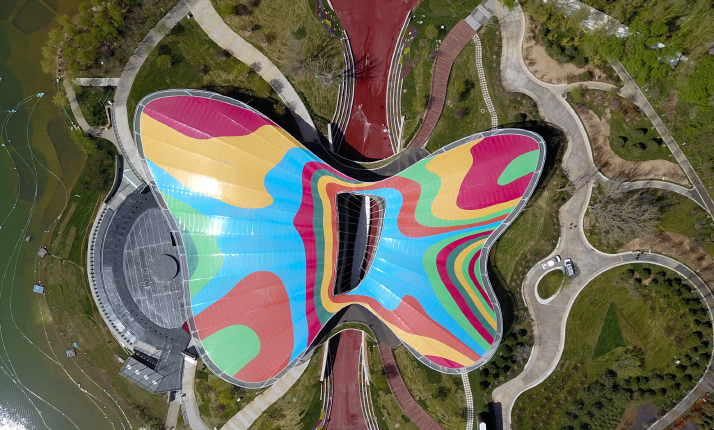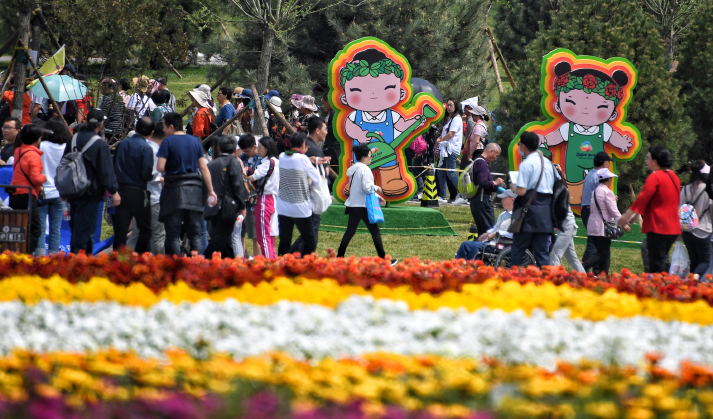|
||||||||||
| Home Nation World Business Opinion Lifestyle ChinAfrica Multimedia Columnists Documents Special Reports |
|
||||||||||
| Home Nation World Business Opinion Lifestyle ChinAfrica Multimedia Columnists Documents Special Reports |
| ChinAfrica |
| Planting a Green Ideology |
| The 2019 Beijing International Horticultural Exhibition gives a timely attractive boost to green living |
| By Xia Yuanyuan | VOL.11 September ·2019-08-27 |

Shandong Pravilion at the 2019 Beijing Expo (WEI YAO)
At the foot of China's iconic Great Wall, about two hours' drive from central Beijing, a colorful parade of float-carrying vehicles welcomes hordes of visitors to the 2019 Beijing International Horticultural Exhibition (Beijing Expo).
The innovative floats, accompanied by performers in dazzling costumes, are made up of sculptures incorporating thousands of flowers, with each float representing a unique cultural theme. A crowd favorite is the giant floral panda, China's national animal, which winds its way with the other vehicles through the 503-hectare expo park, becoming an instant backdrop to a stream of selfies.
The Disney-like entertainment adds a carnival atmosphere to the expo in Yanqing District, open from April 29 to October 7, which is expected to attract 16 million local and foreign visitors over the 162 days of operation.
This is the second time China has held a top ranking A1-level horticultural expo, after Kunming, the capital city of southwest China's Yunnan Province, held in 1999.
According to the Beijing International Horticultural Exhibition Coordination Bureau (BIHECB), the exhibition showcases a huge collection of over 1,200 species of plants from different countries. The Live Green, Live Better themed expo attracted more than 110 countries and international organizations, marking the highest attendance in the expo's history. Many countries have opened national pavilions, demonstrating their unique cultures as well as buildings incorporating green development. China's 31 provincial-level regions showcase unique features from their regions.

An aerial view of the butterfly-shaped Guirui Theater at the Beijing Expo (XINHUA)
Green wonderland
A 20-meter-high greenhouse that covers 3,000 square meters includes everything from rare plants like ferns of the dinosaur period and sea coconuts to beautiful orchids and other exotic flowers.
As one of the four major attractions, the Plant Pavilion gathers more than 1,000 plant species, including over 100 unique species from across the world. A 19-meter-tall, 20-ton banyan tree, transported from southwest China's Yunnan Province, is affectionately known as the "treasure of the pavilion." Along with mangroves, tropical rain forests, ferns, palms, carnivorous plants and moss, the botany on display presents a vitality-infused wonderland of plants for visitors to experience.
The pavilion also features a rooftop garden filled with colorful, sweet-scented flowers and a plant genetics laboratory where visitors can learn about the latest scientific achievement in plant genome sequencing.
"The theme of this exhibition is 'miraculous wisdom,' which introduces the survival secrets of different plants," said Wang Yuan, a greenhouse engineer at the expo. According to him, half of the 1,000 plant species in the pavilion are from China, and the rest is from as far afield as the Americas, Africa, and Australia.
Apart from plants, the expo showcases a large collection of flowers, including more than 1,200 species indigenous to China, such as the peony, lotus, orchid, camellia and rhododendron, according to Zhou Jianping, Executive Deputy Director General of the BIHECB.
In addition to domestic species, more than 1,000 foreign flower varieties are on display that can adapt to Beijing's climate and have a high decorative effect, enabling visitors to visit the world's floral kingdom in one place.
Along with plants and flowers, fruits, vegetables and herbs are also featured at the expo. "Since April 5, three planting bases in Yanqing began to supply vegetables to the expo's vegetable garden. As of April 10, a total of 60,000 pots of vegetables had been transplanted," said Zhang Hongyuan, head of the vegetable project of Beijing Dongsheng Seeding Industry Co. Ltd.
"The expo is a window to know about more plants on earth," Wang Zhengyu, a visitor from Henan Province, told ChinAfrica. "It's also a chance to raise people's awareness to protect the environment with a better understanding of mysteries of plant growth."

The Beijing Expo attracts a large number of visitors (XINHUA)
Ecology first
"Eco-friendly concept" was emphasized throughout the exhibition's preparation work, including planning, design and construction by organizers.
To the east of the expo, two rows of tall dryland willows sway in the breeze. "These trees are native to the area," said Hou Shuang, head of the expo design team. According to her, in order to preserve the original landscape, the expo site is shaded by nearly 50,000 trees that are native to the area together with another 200,000 newly planted trees.
"For those residents who once lived near the expo, they can still have a sense of familiarity when they visit the place. Retaining the trees is to retain the roots of the land and retain the memories of home," said Hou.
In order to protect these trees, the design team specially adjusted the design plan to accommodate the height of the buildings according to the height of the trees. "Although the cost and difficulty [of construction] increased, the trees have been saved, so I think this is ecology ideology," said Hou.
Preserving native dryland willows is only one part of the expo's drive for ecological protection. On the roof of the Chinese Pavilion, over 1,000 photovoltaic glass panels have been installed to utilize solar energy. A rainwater collection system and an underground storage pond are used to irrigate the terraced field on which the pavilion is built. With the help of modern technology, the pavilion makes good use of the environment while preserving the local ecological system.
In addition, for every ticket sold at the exhibition, the organizers will donate part of the proceeds to the China Environmental Protection Foundation to support the country's sustainable environmental development.
"I hope the green development concept embodied by the expo can spread to every corner of the world," Chinese President Xi Jinping said at the opening of the horticultural expo. "Every generation has its own mission. Our efforts to conserve the ecosystem will benefit not only this generation, but many more to come," said Xi, demonstrating China's determination to continue on the road of green development.
Long-term benefits
It is no easy feat for Yanqing District to host the world's largest horticultural expo seven years after representing Beijing winning the bid.
Compared with other regions around the capital, the traffic and weather conditions of Yanqing were not the best. Regarding natural environment, with an average elevation 500 meters higher than central Beijing, the temperature here is 5 degrees lower than the capital throughout the year.
However, the district made a big effort to prepare. Since 2012, Yanqing has improved its urban environment and beautified its landscape by planting a total of 10,667 hectares of forest, with 667 hectares of trees planted around the expo park, said Yu Bo, the district chief. Since 2017, the district has developed its horticulture industry by bringing in more than 30 registered floriculture companies from Zhongguancun, the tech hub in the capital's Haidian District, and has established a horticultural business district near the expo park.
Nearly 60 million flowers and 1,603 species of plants have been cultivated in the business district, said Wang Shuqin, Deputy Director of the Zhongguancun Yanqing Science Park. Seedlings and flowers grown there are delivered to the exhibition park on a regular basis.
"We residents feel delighted that our home is becoming beautiful with expanding green areas and good urban planning. To host such a big event is a great opportunity for Yanqing," local resident Wu Tong told ChinAfrica.
The district has also seen huge improvements in infrastructure and public services.
In preparation for the expo, Yanqing strengthened infrastructure with the construction of 13 roads that stretch 54 km in and outside of the region to connect the expo park with neighboring cities. The Yanqing-Chongli (Zhangjiakou, Hebei Province) Expressway opened at the beginning of this year, and the Beijing-Zhangjiakou High-speed Railway is expected to go into operation in the near future, which will shorten the travel time to half an hour from downtown Beijing.
"In the past, transportation was our Achilles heel," said Wu Shijiang, deputy chief of the district. The poor transportation facility has been a big obstacle for local tourism development. "However, it now feels like we have opened a door, allowing us to embark on the fast lane of development."
The improvement of infrastructure and environment is promoting local economic transformation and upgrading, especially boosting the local tourism industry.
"Now, we see a rising number of tourists from central Beijing, other provinces and even abroad, particularly on weekends, thanks to the opening of the expo," Meng Xiangrong, a local villager who runs a rural homestay neighboring the expo park, told ChinAfrica.
According to Zheng Aijuan, an official with Yanqing's tourism commission, so far, 124 such homestays are available, which are mostly converted rural houses, enabling tourists to have "a sense of nature and simplicity."
Sharing experiences
Yanqing is not the only piece of land in China to be greened.
In recent years, as China has implemented its new concept of innovative, coordinated, green, open and shared development, and made intensive efforts to control pollution with the enforcement of stricter laws and regulations on environmental protection, people are benefiting from the efforts.
Taking Beijing as an example, residents in the capital enjoy more blue-sky days than they did several years ago. The average concentration of fine particulate matter PM2.5 in the capital dropped from 89.5 to 51 micrograms per cubic meter last year, or 43 percent. The local government's pollution control efforts contributed 65 percent of the decrease, according to He Kebin, Academician of the Chinese Academy of Engineering and Dean of Tsinghua University's School of Environment.
A good example of this greening effort is also found in Shanxi Province.
In the expo park, by displaying a variety of locally cultivated flowers, the indoor exhibition hall of Shanxi Province inside the China Pavilion is a highlight.
Themed New Shanxi on the Crown of Flowers, the exhibition demonstrates the transformation of Shanxi, long a powerhouse of coal and steel production, from a traditional coal mining and resource-consuming province to one that is green, beautiful and making progress with a continuous and cyclical use of resources.
"These beautiful flowers represent our yearning for a better and richer life," said Qin Zexin, a guide in the provincial hall.
"The exhibition gives a message to people all round the world that China is looking after its ecology, which is highly aligned with the UN's 2030 Sustainable Development Goals," said Ibrahim Thiaw, Executive Secretary of the United Nations Convention to Combat Desertification.
According to Thiaw, China has a lot to offer in terms of lessons. China's experience proves to the world that ecological construction contains infinite economic value. Ecological construction, improvement of residents' environment and sustainable economic development can be achieved in one action.
Many years ago, he was in China and witnessed the comprehensive benefits brought by the Central Government's launch of the national-level forestation project - the Three-North Shelterbelt Forest Program (Northwest, North and Northeast China) in the northern regions of China. The total area of forestation achieved by the project in the past 40 years has reached 30.14 million hectares, and it has helped restore a total of 204,800 hectares of degraded forests.
"The expo will become an important platform for the exchange of experiences between China and the participants, and will help improve environmental awareness in Arab countries and the ability to control desertification," said Fayqa Ashkanani, Deputy General Commissioner of Qatar Pavilion.
(Comments to xyy@chinafrica.com)
|
||||||||||||
| About Us | Contact Us | Advertise with Us | Subscribe |
| Copyright Beijing Review All rights reserved 京ICP备08005356号-5 京公网安备110102005860号 |